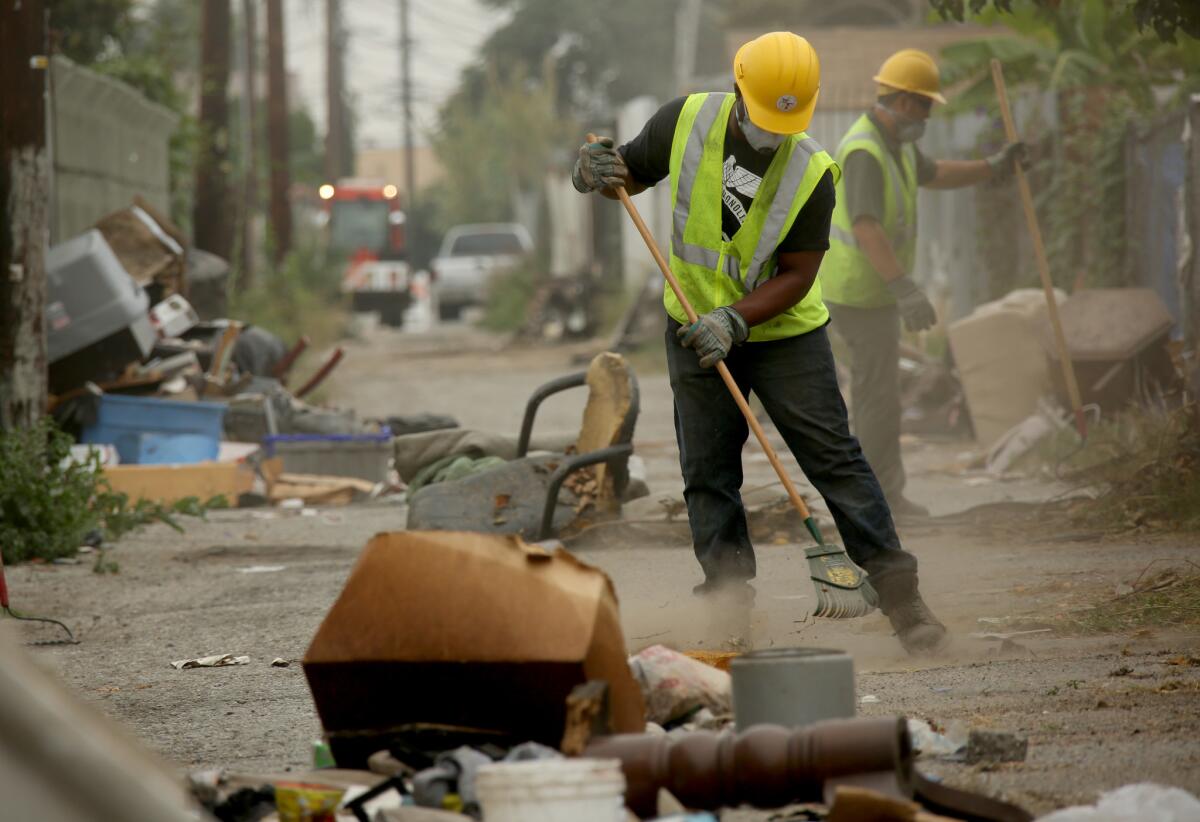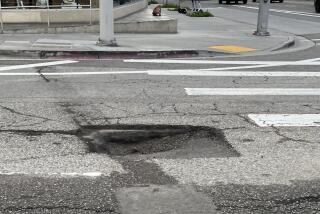Garcetti promised to crunch data to clean L.A. streets — here’s how that’s working

- Share via
When Eric Garcetti was elected mayor of Los Angeles in 2013, he promised a “back to basics” platform. His goal was to improve core city services that had languished during the recession and left residents frustrated that City Hall was failing to fix the quality-of-life issues that matter most.
He vowed to use data to measure performance and hold department managers accountable, and to share that information with the public so it could judge whether the city was meeting its goals.
One of City Hall’s biggest pushes was to clean up the streets of L.A., which residents had long complained were filthy and seemingly impossible to get the city to clean.
By this measure, Garcetti’s approach shows signs of success.
Since he took office, the overall cleanliness of city streets, curbs and alleys has improved while crews are responding faster to complaints of potholes, illegal dumping and graffiti, a Times review of public works data shows.
It’s all a notable change from four years ago.
Back then, mounds of garbage, construction debris and discarded couches clogged alleys in parts of South L.A., the central city and the Eastside. Thousands of sidewalks were impassable or dangerous, leading to millions of dollars in payouts for trip-and-fall lawsuits each year. City streets had deteriorated for decades, with potholes forming faster than workers could patch them.
Last spring, the city launched CleanStat, a data collection and mapping system that allows officials to track illegal dumping, bulky items, litter and weeds, and establish cleanup priorities across 114 neighborhoods.
During the first survey in early 2016, more than 370 miles of streets and alleys — mostly in South L.A. — were so dirty they required immediate cleanup. By the end of last year, that figure had fallen to 91 miles, or about 1% of city blocks, the analysis found.
Ron Smith lives on West 107th Street near an alley that had long been a magnet for illegal dumping of tires and furniture. Since crews cleared the debris in 2015, the alley has been relatively clean, Smith said. He’s also noticed less trash in the neighborhood in general.
“I have seen an improvement and I was quite surprised,” Smith said.

The Los Angeles Bureau of Sanitation will use a data-driven rating system to prioritize the grimiest areas of the city and deploy cleanup efforts there.
Despite the progress, some lagging service areas remain, said Councilman Marqueece Harris-Dawson, who represents the South L.A. district where Smith lives.
Residents there have given “high marks” for the cleaner alleys, but there are ongoing litter and weed problems along commercial corridors such as Western Avenue and Martin Luther King and Crenshaw boulevards, he said.
“You just don’t see a demonstrable change there,” Harris-Dawson said.
Officials said the city has come a long way from the unkempt conditions described in an internal city report in 2014. It found that some L.A. neighborhoods were in a “constant state of uncleanliness” that threatened the city’s image.
A follow-up report from the city administrative officer in 2015 recommended that the city create a “cleanliness rating index” to rank the filthiest areas, which eventually led to the development of CleanStat. The system has also helped crews respond faster to requests because inspectors file service requests as they see dumped mattresses or garbage in the field, officials said.
Other technological gains have helped crews work more productively. Sanitation drivers used to rely on a pen-and-paper system to pick up illegally dumping or bulky items, which led to duplication, officials said. Now hand-held devices give them real-time updates from the city’s service-request database.
More residents are using the city’s mobile MyLA311 app and website to file cleanup requests. About 20% of requests came through those channels last year, compared with 2% in 2013.
Graffiti removal also has gotten speedier since 2013, with crews responding to nearly two-thirds of requests within a day, records show. Workers last year fixed potholes in 2.5 days on average — half the time it took two years prior.
In 2015, Garcetti ordered the sanitation agency to install 5,000 new trash cans over a four-year period after a city report found that L.A. lagged far behind other large cities. The city is ahead of pace to hit that number, according to the sanitation agency.
Barbara Romero, deputy mayor for city services, said she believes the data-guided approach has increased accountability among city agencies and improved public trust. The city now prioritizes areas of greatest need to deliver services more equally to its nearly 4 million residents.
Garcetti “really made an impressive investment in data and systems and how we can deploy those right resources in the right places at the right time,” Romero said.
Keeping the city clean isn’t the only issue facing L.A. leaders — they also have to maintain the largest municipal street and sidewalk network in the country.
Overall street quality now stands at a C grade, improving about 6% since 2013 as crews repave more miles and patch more potholes each year, city records show.
L.A. has stepped up sidewalk fixes since 2015 when city leaders agreed to a $1.3-billion lawsuit settlement filed by disability rights’ groups. That money will be used to repair walkways over the next three decades. In the last two years, crews have repaired more than 800,000 square feet of walkways and ramps, public works officials said.
The progress on services hasn’t come without hiccups, mostly in the form of uneven services.
In 2015, Garcetti ordered an internal investigation into how the sanitation bureau handled requests for illegal dumping after a Times analysis showed lagging trash cleanups in areas of central, northeast and South L.A. He later ordered agency officials to clear a backlog of tens of thousands of outstanding illegal-dumping requests.
Another Times report that year found large geographic disparities in how the city handled pothole repair, bulky item pickup and graffiti removal.
Kevin James, president of the Board of Public Works, said the key to fixing the equity issue is analyzing information collected by his department.
“For us to solve it, we use data,” James said. “We use that data to be successful. Are we there yet? Not yet. But in the last 3½ years, the progress is real, it’s recognized and residents that we hear from feel it.”
Harris-Dawson was a vocal critic of the city’s subpar service his constituents had received when he took office in 2015. Almost two years later, he said conditions have improved and credited the implementation of the city’s cleanliness system.
“I think there is acknowledgement and documentation of inequity,” Harris-Dawson said. “CleanStat gives us the tool to look at it in a real, objective way, which we didn’t have before. That kind of takes the emotion out of it. The data is the data. These are the facts as they are in front of us.”
Twitter: @bposton
ALSO
Developers are finally taking interest in South L.A. Will Measure S kill those dreams?
‘Law & Order’ creator suffers legal setback in fight to sell Central Coast groundwater
Body of missing 14-year-old found in L.A. River after weeklong search
More to Read
Sign up for Essential California
The most important California stories and recommendations in your inbox every morning.
You may occasionally receive promotional content from the Los Angeles Times.














